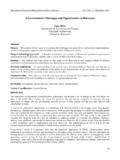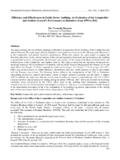Transcription of Tranexamic Acid Use in the Total Hip and ... - IOSR Journals
1 IOSR journal of Pharmacy and Biological Sciences (IOSR-JPBS) e-ISSN:2278-3008, p-ISSN:2319-7676. Volume 12, Issue 2 Ver. III (Mar. - ), PP 01-05 DOI: 1 | Page Tranexamic Acid Use in the Total Hip and Total Knee Arthroplasty Population at an Academic Medical Center: a Retrospective Review of Postoperative Outcomes Brianne E. Kaufman, ,1 Julie A. Murphy, , FASHP, FCCP, BCPS,2 Natalie Tuttle, , BCPS,1 Daniel Gehling, MD3 1 Pharmacy Services, University of Toledo Medical Center, USA 2 Pharmacy Practice, University of Toledo College of Pharmacy and Pharmaceutical Sciences, USA 3 Orthopaedics, University of Toledo Medical Center, USA Abstract:Purpose: Excessive blood loss and subsequent blood transfusions in orthopedic procedures have been associated with considerable morbidity and mortality.
2 The primary objective of this study was to determine the incidence of perioperative blood transfusion after hip or knee arthroplasty with the use of Tranexamic acid (TXA) versus standard of care. Methods: Any adult patient who underwent a Total hip or knee arthroplasty between October 1, 2012 and September 30, 2015 was eligible for inclusion. Patients received 1000 mg of intravenous TXA preoperatively. Results: Two hundred ninety-eight patients were included, 148 in the TXA group, and 150 in the standard of care group. In the TXA group, 30 patients required a blood transfusion, versus 48 patients in the standard of care group (p= ). Conclusion: TXA was associated with a significantly lower need for blood transfusion and shorter median hospital length of stay without an increase in thromboembolic complications.
3 Keywords: arthroplasty, blood transfusion, thromboembolic complication, Tranexamic acid I. Introduction Hip and knee arthroplasties are becoming increasingly more frequent procedures in the United States, with orthopedic cases of this type expected to double in the next 10 years[1].One safety concern from these surgeries is the risk of bleeding. In fact, the cost of blood management for knee arthroplasty has increased over 80% from 1991 to 2008[2].Many strategies to prevent the need for blood transfusion and limit the overall cost of these procedureshave been used. The use of Tranexamic acid (TXA) in hip and knee arthroplasties has been studied to decreasethe need for blood transfusions, decrease hospital length of stay, and reduce overall cost.
4 TXA is a synthetic analog of the amino acid lysine. It providesan antifibrinolytic effect through competitive inhibition of the lysine binding site of plasminogen activation and, at higher concentrations, acts as a noncompetitive inhibitor of plasmin. It is often used for this antifibrinolytic effect in orthopedic surgeries such as Total hip or knee arthroplastyin an effort to decrease intra- and postoperative bleeding. This use is not FDA-approved, as TXA is only FDA-approved for the treatment of hemophilia and menorrhagia. However, several hospitals have implemented protocols for the use of TXA in their orthopedic surgeries. Debate exists on the most effective route of administration for TXA in this setting, as oral, topical, intraarticular, and intravenous (IV) dosing strategies have been reported.
5 Regardless of route, evidence to support the routine use of TXA in Total hip or Total knee arthroplasty has developed over the past retrospective patient chart review, we compared the characteristics and outcomes between patients receivingpreoperativeTXAwith those receiving standard of care to minimize bleeding, and subsequently analyzed whether the use of TXA was associated with reduced rates of blood transfusion. We hypothesized that the use of TXA reduced the need for blood transfusions without increasing postoperative thromboembolic complications. II. Methods The study was approved by the local ethics committee and was performed in accordance to the Declaration of was a single center, retrospective cohortexamining the rates of blood transfusion in patients who received TXAversus standard of care alone perioperatively.
6 Standard of care was defined as strategies to minimize bleeding, including routine hemostasis during surgery, regional anesthesia, etc. Patients who received TXA also received standard of care. The charts of patients 18 years of age or older who underwent Total knee arthroplasty, Total hip arthroplasty, knee revision, or hip revision between October 1, 2012 to September 30, 2015 at the academic medical centerwere reviewed. Patients were excluded if they had a hypersensitivity to TXA, religious objection to autologous blood transfusion, or were pregnant. The main intervention variable was the use ofTXA 1000 milligramsintravenouslygiven immediately prior to the initial incision, according to institution-approved policy; the policy went into effect in September 2013.
7 Tranexamic Acid Use in the Total Hip and Total Knee Arthroplasty Population at an Academic DOI: 2 | Page The primary outcome was to determine the incidence of blood transfusion requirements in patients receiving TXA versus standard of care. The need for blood transfusion was documented via premade blood transfusion order sets that were scanned into the patient s medical record. Any blood transfusion that occurred intraoperatively or postoperatively was outcomes includedhospital length of stay, postoperative thromboembolic complications, hemoglobin levels, and 30-day readmission characteristics analyzed included age, sex, body mass index, and race (white, black, other).
8 Comorbid conditions (diabetes mellitus, hypertension, history of myocardial infarction, history of gastrointestinal (GI) bleed, history of deep venous thromboembolism (DVT) or pulmonary embolism, heart failure, arrhythmias, cerebrovascular disease, chronic kidney disease, cancer, sickle cell anemia, cirrhosis, and hepatitis)were also collected using charted ICD-9 and ICD-10 codes. Preoperative and postoperative hemoglobin values were collected. Preoperative lab values were defined as being obtained within 45 days prior to surgery and postoperativelab values were defined as being obtained up to30 days post-surgery, with the recorded valuenearest to incision or closure time, respectively, used in statistical analysis. Procedure related variables included type of procedure ( Total hip or knee arthroplasty, hip revision, or knee revision), tourniquet time if applicable, length of surgery, use of TXA, theamount of estimated blood loss, and subsequent units of blood transfused.
9 Postoperative variables measured included use of postoperative anticoagulants and the development of a thromboembolic complication during the surgery admission. All anticoagulants, besides aspirin at a dose of 81 mg oraldaily, were considered acceptable forms of post-operative DVT prophylaxis[3]. The data was analyzed using SPSS software (version 23). The association between TXA use and study variables was assessed using 2 tests for categorical variables and t tests for continuous variables. Mann Whitney U was utilized for non-normally distributed variables. A difference of 20% between groups with 80% power was needed to show statistical significance, with 150 patients needed per treatment arm. Differences were considered significant if the p-value was III.
10 Results Two hundred ninety-eight patients were eligible for inclusion. One hundred forty-eight patients received TXA and 150 patients received the standard of careonly. Baseline characteristics were similar between the two groups, except heart failure was more prevalent in the TXA group (Table 1). Table 1: Baseline Characteristics Characteristic TXA (n=148) Standard Procedure (n=150) P value Male, n (%) 60 ( ) 64 ( ) Age (years), mean SD BMI (kg/m2), median (IQR) ( ) ( ) Race, n (%) White 124 ( ) 121 ( ) Black 22 ( ) 21 (14) Other 2 ( ) 8 ( ) Comorbidities, n (%) Hypertension 105 (71) 109 (73) Diabetes Mellitus 52 (35) 47 (31) Arrhythmias 26 (18) 16 (11) Heart Failure 15 (10) 6 (4) Cancer 14 (9) 17 (11) Chronic Kidney Disease 14 (9) 15 (10) Coronary Artery Disease 8 (5) 10 (7) History of thromboembolism 6 (4) 8 (5) Cerebral vascular disease 5 (3) 9 (6) Cirrhosis/Hepatitis 3 (2) 5 (3) History of GI bleed 2 (1) 1 ( ) Sickle Cell Anemia 1 ( ) 0 (0) Primary and secondary outcomes are displayed in Table 2.
















